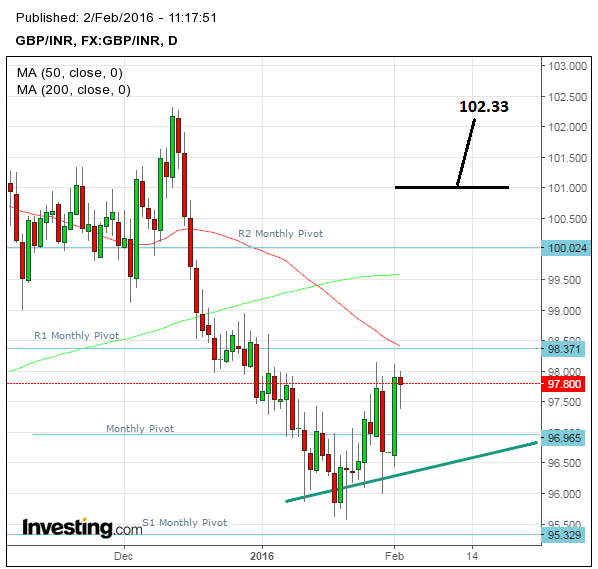Pound to Rupee: More Gains Possible as Support Holds
The pound is advancing against the Indian Rupee as a key level remains firm. Where will the currency pair move from here?

The Indian rupee strengthened by about 20 paise against the pound on Tuesday 2nd February, falling to 97.60, following the Reserve Bank of India’s (RBI) decision to keep rates on hold at their February Rate meeting.
However, in mid-week trade we are seeing the exchange rate move higher once more; the pair is quoted at 98.2348, higher than the previous day's close at 97.91.
Bank money transfers are being quoted at 95.5 while specialist providers are doing so at just below 97.
The RBI left its main lending rate, the repo rate, at 6.75%, its deposit rate, or reserve rate, at 4.0% and the rate at which it borrows, or reverse repo, at 5.75%.
In September the bank cut rates by 50 basis points, however, since the summer of 2015 inflation has been steadily rising and this has been a major factor in the RBI decision to keep rates unchanged.
The RBI is targeting 5% inflation by March 2017, which according to analysts at Barclays is lower than they might expect:
“Indeed, while forecasting 5% CPI inflation by end of FY17, the RBI has not completely factored in the likely impact of the 7th Pay Commission’s recommendations, which will ‘impact upward momentum’ to its inflation forecasts for one to two years, as the implementation process is staggered.”
Technical View for the GBP to INR Conversion - 95 key level.
Since 2013 the rupee has broadly been oscillating in a range of about 5-7 rupees around the 100 rupee to the pound mark.
The currency had been rising since the RBI kept rates on hold after the cut in September 2015.
Pound weakness due to Brexit fears and slowing growth were a factor in the GBP/INR’s descent over the last four months.
From a technical perspective the pair fell to support at a significant multi-year trend-line at around the 96 rupee in January this year.
It failed, however, to breach the 94 level which we stipulated in our own analysis as a significant confirmation level for a trend-line break.
Instead the exchange rate reached 95.58 before springing back up and using the trend-line as ‘foot-hold’ for a rally higher.
Since the 21st of January the pair has been rallying higher, reaching highs of 98.14 on Friday 29th.
Although the rupee has strengthened a little on the mildly hawkish RBI decision, analysts at Barclays still foresee more cuts this year.
Nevertheless, if commodities are basing and there is no further decline for them, one of the major factors keeping Indian inflation down will have been removed and it may continue to rise.
Given analysts’ expectations that the 7th Pay Commission’s recommendations may increase wages and inflation, and that the government could be generous with its budget, as well as the unchanged structural conditions for India’s endemic inflation, there is also a risk it could go on increasing and reversing the RBI's accommodative stance.
With Brexit fears still expected to weigh on the U.K in the mid-term, the rupee could be set to potentially outperform sterling, although tough support at around the 96 level from the major trend-line put a technical limit on rupee appreciation, and as we have said before, we would ideally wish to see a break clearly below the recent 95.58 lows – perhaps below 95.00 - for confidence the trend-line had been definitively broken and the pair was going lower, with the next target at support at 91.50.
Upside is very much capped by the R1 Monthly Pivot at 98.37. and the 50-day MA at about the same level, making a double lock of resistance.
Then there is the critical 100.00 level and the R2 pivot at 100.01 with another double lock not far above, so ideally I’d want to see a clear break above the 101.00 for confirmation of more upside to the 102.33 highs.
Easing cycle since 2015
The central bank had been in an easing cycle in 2015, during which it cut rates four times.
Global disinflation due to the fall in commodities had a pronounced base effect on inflation, bringing it down to historically very low levels in the summer of 2015 and allowing the bank room to cut rates.
However, these base effects seem to be modifying now and inflation is back on the up.
Nevertheless, on Tuesday Governor Rajan said the bank would maintain an accommodative stance, which was interpreted as indicating that further cuts were still on the table and the central bank was still in its easing cycle.
Analysts at Barclays expect the RBI to make further cuts in 2015:
“We see room for a further 50bp of repo rate cuts in H1 16
“Strong, broad-based disinflation allowed the RBI to cut the repo rate 125bp in 2015.
“However, we believe the RBI is cautious about using its remaining monetary space, given prospects of an expansionary budget.”
Barclays put a lot of emphasis on the outcome of the government’s budget, which is expected to be expansionary, and therefore a source of further inflation.












